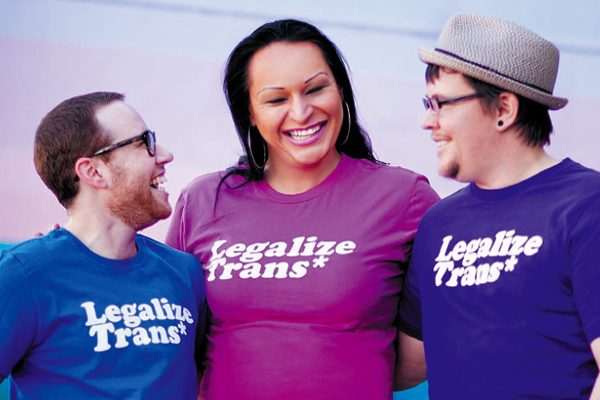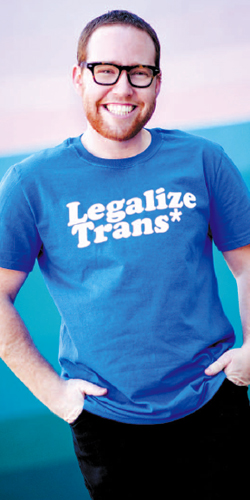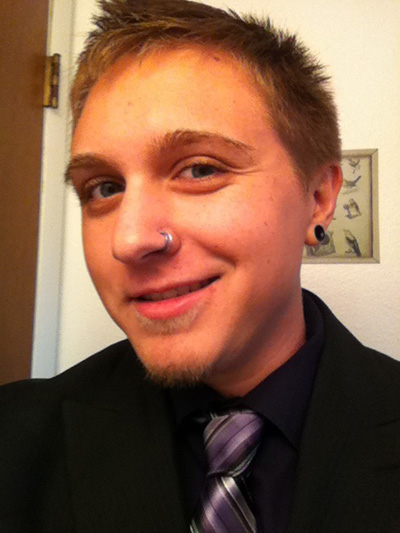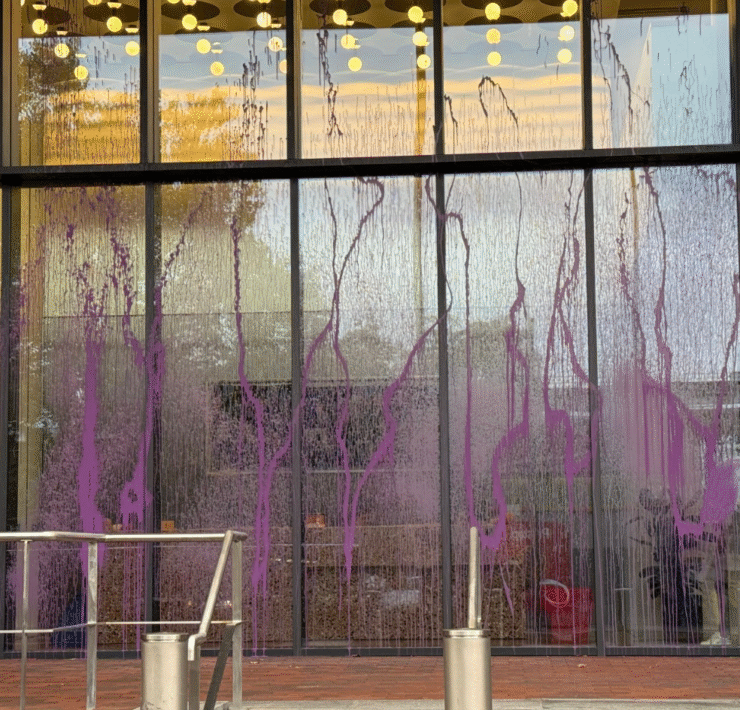A fluid expression: building a better trans* narrative

Josiah Hesse writes music, feature interviews and news coverage for…


When Victoria Mykels-Sexton visited a Southwest Denver DMV – after moving back to Colorado from Las Vegas – the man behind the counter greeted the attractive woman with a smile.
“How are ya’?” he said. But Mykels-Sexton, who had been Victoria for almost a decade in Las Vegas, was still named Anthony Perry in the Colorado DMV’s database.
After the DMV employee discovered that, he didn’t look up from the computer screen. A large M was listed beside Mykels-Sexton’s name. Not an F.
“Just a minute,” he said as he walked to his supervisor. Mykels-Sexton watched as the DMV staff whispered, pointed and called a second supervisor.
“I knew what they were saying,” she remembered. “I’d been through it before.”
The DMV refused to issue Mykels-Sexton a new I.D. describing her as female – ignoring her requests that they look up her Nevada information. It was all too familiar.
Growing up as a hyper, theatrical child who loved dress-up, it was news to no one that there was something different about young Anthony.
“I used to put a towel over my head,” Mykels-Sexton said, “throw on a leotard – stuffing it with socks – and walk around in heels saying my name was Tracy Knight and I was married to Jonathan Knight from New Kids on the Block.”
Mykels-Sexton remembers her mother as “very image conscious, very Stepford Wives,” a woman who didn’t care for her young son’s interest in Barbie dolls and boy bands. When Mykels-Sexton was a teenager her mother chopped her hair, burned all of her feminine clothing and embarked on what Victoria now describes as “reprogramming.” Mykels-Sexton still dressed up – sometimes even performing in drag shows at Rainbow Alley – yet there was an internal conflict throughout her teenage years.
“I went through a bad drug phase. I did everything under the sun. I fought with myself internally, telling myself ‘I’m a boy, I’m a boy.'”

The struggle went on until Mykels-Sexton was 23, when, through the loving intervention of friends, Anthony decided to embrace his inner self: a woman named Victoria. Years later, Mykels-Sexton has carved out a life for herself in Denver, happily dating men and performing drag shows at Broadway’s and Charlie’s.
“My drag career I consider just a persona, my job. Whereas me being a transgendered woman is different; it’s my soul, it’s who I am as a woman. Drag is overembellishment of a woman – it’s a celebration of women.”
Mykels-Sexton told her story by phone, which at first seemed an uncomfortable setting for such personal information. Then she revealed she was face-to-face with a Beauty Supply Warehouse cashier.
“I’m an open book,” Mykels-Sexton explained. Like most drag queens, Victoria is loud, witty and utterly incapable of embarrassment, though unlike most drag queens, she is a full-time woman.
“My philosophy is go big or go home,” Mykels-Sexton said as she paid for a new wig.
The wig Mykels-Sexton bought was for the young boy with her.
“My drag daughter,” Mykels-Sexton explained. “I have 28 drag children, all over the country.”
Referred to as her hatchlings, these young kids receive an encouraging leg-up from their drag mother, empowering them to wear wigs and dresses with no intention of “reprogramming.”
A history documenting lesbian and gay rights in America will likely mention the American Psychiatric Association’s 1973 declassification of same-sex attraction as a mental illness. The 1973 development in LGBT history is used to push back against homophobic institutions, illustrating the normality of homosexuality and the advances made in a progressive society.
 What is rarely mentioned is the APA’s continued use of the term “Gender Identity Disorder.”
What is rarely mentioned is the APA’s continued use of the term “Gender Identity Disorder.”
To this day, any mental health professional assessing a patient with a gender identity different from the one he/she was born with will – according to the textbook the doctor was educated with – assess the person as suffering from a “disorder.” If that patient wants to be admitted for hormonal or surgical treatment, the patient must confess to having it.
It seems that while the “T” in LGBT sits snugly next to its counterparts, society has come farther in accepting the rest of the acronym. Over the years, battles over gay marriage have brought same-sex couples to the living rooms of America on the evening news, Modern Family and Will & Grace, but transgender persons have received comparatively less positive attention.
As Tom Hanks was gave credence to the AIDS epidemic of gay communities in Philadelphia, films like Mrs. Doubtfire were stirring up laughs at the hysterical notion of cross dressing – inevitably spawning the peculiar trend of male comedians dressing up as old ladies in an endless string of straight-to-video movies. When Chaz Bono confessed to gender reassignment surgery in 2009 – making him the closest we’ve come to a trans household celebrity – it had already been a good 12 years since Ellen Degeneres’ “Yep, I’m Gay,” Time Magazine cover made her the first lesbian even your grandmother had heard of.
While society still has plenty of room to grow when it comes to gay rights, the same logic that concludes the phrase “that is so gay” can potentially lead to gay bashing suggests that an absence of sober respect given to trans issues in government, science and media also leads to a mess of dangerous ignorance.
“There is a term called trans-panic,” said Crystal Middlestadt, director of training and education for the Colorado Anti-Violence program. “It’s a way to point the finger at the victim [in a courtroom]. If someone didn’t come out as transgender right away to someone, then they’re blamed for that person assaulting them.”
Middlestadt said while this defense wouldn’t lead to dropped charges, it does “attempt to play on the [anti-trans] bias of the judge or the jury. It can be the way to take something from a first degree to a second degree murder charge.”
Consider the 2002 murder of Gwen Araujo in Newark, California. Four men strangled and buried Araujo after discovering during a sexual encounter she was trans. The jury found two of the defendants guilty of only second-degree murder, the other two of manslaughter.
In 2007, Colorado became the 11th state in the U.S. to include transgender identity in hate crimes legislation. Two years later, Colorado became the first state in the nation to exercise the legislation, finding Allen Andrade guilty of hate crime murder in the first degree for bludgeoning his 18-year-old date, Angie Zapata of Greeley, to death after discovering she was biologically male. Andrade was sentenced to life in prison without possibility of parole.
In his first two years in office, former Gov. Bill Ritter, a Democrat, signed two additional laws expanding trans rights in Colorado: the expansion of the “Employment Nondiscrimination Act” to include LGBT persons; and a similar expansion of the “Colorado Anti-Discrimination Act,” which forbids bigoted exclusion from public accommodations and housing.
But the road toward trans equality is still littered with reminders of how far we have to go. Last fall Colorado 9 News reported that a transgender student at Fort Collins High School was suspended for using the “wrong” restroom; and this January The Girl Scouts of America came under fire for (eventually) admitting a transgender girl into a Colorado troupe.
Hell, there was even a public freak-out over a J. Crew ad displaying a boy with painted toenails.
It’s no surprise that growing up LGBT in a world where toenail painting is cause for alarm can make for an awkward childhood. Thankfully there are those who walked through the fire of childhood persecution and are on the other side, happy and healthy and paving a smoother road for the generation behind them.

After seeing him speak at a 2006 University of Colorado Boulder conference titled “Transforming Gender,” directors of Jefferson County Alternative School invited Dylan Scholinski to work with them. Impressed with Schlonski’s Sent(a)mental Studios – an art program for at-risk youth in memoriam for LGBTQ suicides – they felt that their own at-risk students could benefit from some creative therapy.
“I want to give kids the opportunity not only to find their own voice,” Scholinski said, “but to be led by someone who’s not trying to mold them into something they aren’t.”
Like Mykels-Sexton and her mentoring of “drag daughters,” Schlonski is trying to provide his students with an opportunity he was not afforded as a child.
Born female, Dylan (then Daphne) exhibited familiar signs of a transgender child: namely, a complete disinterest in activities society attributes to the gender she was assigned at birth.
At 15 Daphne was enrolled in a more extreme version of Mykels-Sexton’s mother’s “reprogramming:” Diagnosed as an “inappropriate female,” Daphne spent her teen years hospitalized at three different mental health centers, all of which taught her to apply makeup and move with feminine body language.
The process netted the hospitals over a million dollars in fees.
Scholinski chronicled the story in the memoir The Last Time I Wore A Dress.
Now as Dylan, Scholinski has appeared on Dateline, 20/20 and Today bringing light to an issue that was once dealt with so brutishly. He is now devoting his life to creative therapy and the issue of gender identity.
“With homosexuality, you are in charge, most of the time, of that ‘diagnosis,'” Scholinski explained, “but with Gender Identity Disorder it’s not about how you view yourself, it’s about not fitting what society wants of you. The fact that I may be mistaken for something else in the restroom somehow became a disorder of mine.”

Scholinski asserts that even progressive LGBT communities often pigeonhole the transgender experience into simplistic, binary roles.
“When people ask me when I ‘transitioned,’ I don’t have an answer for them. If I identified as a woman this is (still) what I would look like,” Scholinski said, sporting a small beard and a baseball cap. “But I haven’t identified totally as a man.”
In the gay community, gender is often a source of contention. In Out Front Colorado‘s January story on the queer dance scene in “Damn The Man,” queer activist Israel Oka said “the gay scene seems to stick to a binary gender, but some queers don’t fit with either of those genders, or both, or somewhere in between. I know my gender, my identity, can change from day-to-day. Or hour to hour.”
“I didn’t have the typical trans-narrative experience – because I don’t feel that I’ve always been this way,” said Kelly Shortandqueer, a bearded, transgender male who feels that it can sometimes be stigmatizing to not have had the binary experience of female-to-male.
“In high school I had hair down to my butt, tied my shirts in the back and wore skirts. It didn’t feel like I was forcing myself,” Shortandqueer explained. “It felt right at the time.”
Shortandqueer (a name Kelly picked up performing in a variety show called the Tranny Roadshow) is a close friend of Sholinski who has also devoted himself to providing a space for young people to be who they are.
At a young age Shortandqueer found refuge in the DIY Zine community, a worldwide, underground network of home-made books and quarterlies that have been a safe space for much of the LGBT community over the last forty years. It’s a place Shortandqueer found he could express himself through writing. Now director of the Denver Zine Library – one of the largest zine libraries in the world – Shortandqueer provides a space for other young “misfits” to find a home and an avenue of creative release.
Shortandqueer, now a recognizable face and voice for the queer community, didn’t have the same childhood challenges Scholinski did. Aside from a few hiccups, his family has been mostly accepting of his identity and continue to encourage him in his efforts to vocalize the trans experience, Shortandqueer said.
Last year, Shortandqueer released “Shortandqueer #16,” (his own series of autobiographical zines) which included a Q&A interview with his grandfather, Bill Sabin, a World War II veteran.
Sabin is warm and charming as he reflects on LGBT soldiers during the war, as well as how much he enjoyed spending time with Kelly as a little girl.
“As far as you changing, it didn’t matter to me,” Sabin reflected on Kelly’s transition. “I’m glad that you’re happy. It’s all that counts.”
Despite Sabin’s stumbling through the new vocabulary necessary to describe transgender experiences, his eagerness to understand and comply with his new grandson’s wishes speaks largely to the unarguable love he has for Kelly. Sabin was the first of the family to refer to Shortandqueer with by his new preferred gender pronouns – one of the biggest stumbling blocks for families of trans people.
 Scholinski, recently reunited with his estranged father, explained to his father that when referencing his teenage years it’s acceptable to refer to Sholinski as “her;” even using the name Daphne is fine.
Scholinski, recently reunited with his estranged father, explained to his father that when referencing his teenage years it’s acceptable to refer to Sholinski as “her;” even using the name Daphne is fine.
Many transgender sons and daughters understand how ingrained the gender pronouns they were assigned at birth are in the minds of those who knew them when they were young. What they ask is that families use the preferred name and gender designation for the present and future.
Yet, for Schlonski and Shortandqueer, using the pronoun “he” doesn’t necessarily box them into the role of being male.
“I don’t identify as one-hundred percent male,” Shortandqueer said. “That’s just the closest to what feels right.” Shortandqueer said he still sometimes puts on a skirt or a wig, which he doesn’t consider in conflict with being a man, just as Victoria Sexton can be both a drag queen and a full time female.
Many trans people prefer gender to be fluid, not just “A” and “B.” Transitioning is not becoming “something else” as much as removing the obstacles preventing them from expressing the identities they experience – whether male, female, or both.
Corrections: in the first version of this story, Dylan Scholinksi was misspelled “Dylan Schlonski” and Victoria Mykels-Sexton was misnamed “Victoria Mykels Sexton.”
Read More:
Trans 101: “Trans,” “Transgender” or “Transgendered?”Trans* is an abbreviation for a range of people outside gender binary. Transgender refers to people who identify as other than the sex they were assigned at birth, while transgendered is considered outdated.
Click Here for more. |
What's Your Reaction?
Josiah Hesse writes music, feature interviews and news coverage for Out Front Colorado.



 “’Transgendered’ is kind of a sore subject; a lot of people use it incorrectly,” said Mac Simon, queer transman and Northern Colorado Organizer for LGBT advocacy organization One Colorado. “You can’t ‘transgender’ somebody so they can’t be ‘transgender[ed].’ Go with ‘transgender’ to be safe.”
“’Transgendered’ is kind of a sore subject; a lot of people use it incorrectly,” said Mac Simon, queer transman and Northern Colorado Organizer for LGBT advocacy organization One Colorado. “You can’t ‘transgender’ somebody so they can’t be ‘transgender[ed].’ Go with ‘transgender’ to be safe.”







